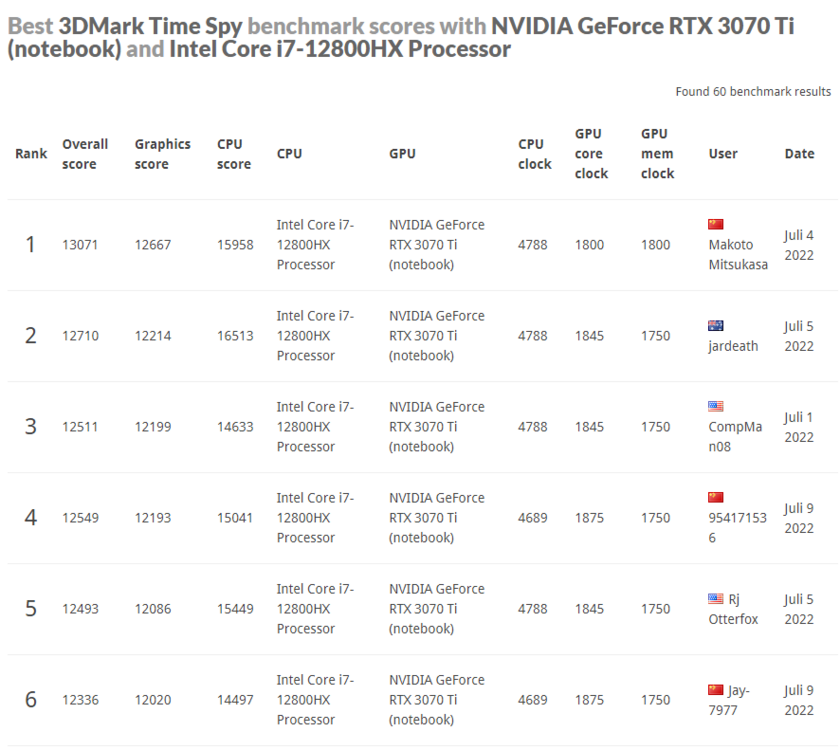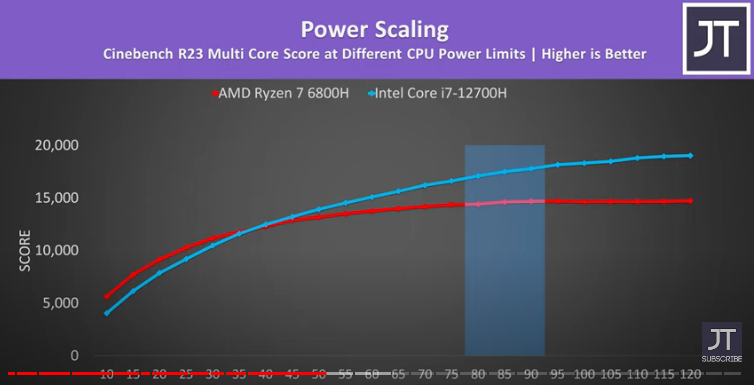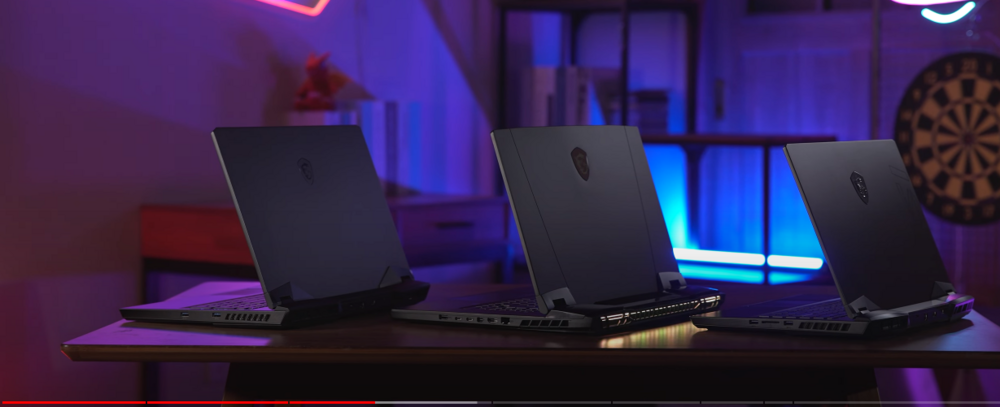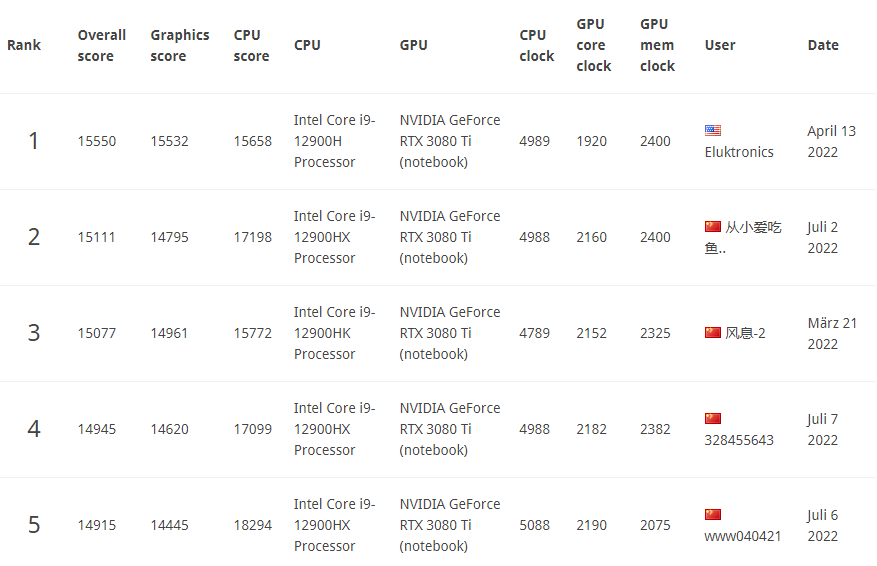
1610ftw
Member-
Posts
1,249 -
Joined
-
Last visited
-
Days Won
2
Content Type
Profiles
Forums
Events
Everything posted by 1610ftw
-
Looks like the 3070 Ti that for now the systems with the 12800HX are somehow gimped at least for Time Spy: Looking at the leaderboard for all 3070 Ti systems there are a bunch of users with I believe the GE76 or a Uniwill/Tongfang chassis that average about about 2000 more in the graphics score which is more than most 3080 Ti systems!
-
I posted the video as it also shows (minimal) speed differences between DDR5 at 3600 and 4800.
- 973 replies
-
- 1
-

-
- dell precision 7770
- dell precision 7670
- (and 6 more)
-
Understood - it really sucks to not be able to properly improve the cooling on these if one is not keen on voiding the warranty and then paying obscene amounts of money for the whole BGA extravaganza. It is funny how one can look at the chassis of the GT77 or GE77, turn off the lighting and they look at least enough business like not to be an embarrassement in a professional setting and then we have the ROG laptops that are screaming "I am a gamer" including some silly sound effects when being turned on.
-
Oh no, not back to 64 GB again, memory usage over here usually oscillates between 70 and 90 GB (currently 88) so that is no option. Interesting that you mention the 3600 speed limit - that is really quite low compared to the 4800 max that is possible with 64 GB but it really only seems to be important if you are interested in the last one or two percent of speed in some benchmarks or gaming so I wouldn't lose any sleep about it. Here is a video from der8auer about a DDR5 to DDR4 comparison and it also shows DDR5 speeds of 3600 and 4800 - very small differences:
- 973 replies
-
- 2
-

-
- dell precision 7770
- dell precision 7670
- (and 6 more)
-
Even if I would get 15% off it would still be a lot of money spent where before I could just have used my existing memory. In the long run I am sure that prices will go down if other manufacturers get on board but at least for this generation Dell is the only company offering it so it is what it is.
- 973 replies
-
- dell precision 7770
- dell precision 7670
- (and 6 more)
-
That sounds like very good savings for a product that has not even come to market and IF you want those 5 years ProSupport. Never mind that you are still dropping something like 5.5K on a laptop 😁
- 973 replies
-
- 1
-

-
- dell precision 7770
- dell precision 7670
- (and 6 more)
-
This is definitely a year where I would suggest to sit things out for people who need a 17.3" classic work station and 128 GB. Dell is the only choice and imo just too much because of that. For people who do not need a swappable GPU the MSI CreatorPro X17 may be an alternative but it is limited to various combinations of the 3070 Ti and 3080 Ti with the 12800X and 12900X, no other CPU and GPU options. And the screen is 4k 120Hz only.
- 973 replies
-
- dell precision 7770
- dell precision 7670
- (and 6 more)
-
I would first suggest to check the mode that was recommended by @win32asmguy and then have a look at the bios. For very simple undervolting you can probably just go with Throttlestop alone, I have yet to encounter a higher performance PC or laptop where it did not work for me with an undervolt of usually between 50 and 125mV. Here is the guide that I used for it first time and what I always adjust (if available) is the undervolting and the multipliers: https://www.ultrabookreview.com/31385-the-throttlestop-guide/
-
So did it thermal throttle in one run or with multiple runs only? Goes to show that even with a unified vapor chamber, Liquid metal and an advertised combined CPU and GPU power budget that is much higher there still is thermal throttling.
-
I just checked the configurator for Dell Germany and as expected the CAMM modules are an issue. Last generation I got the 7760 with 32 GB of memory and 256GB of storage and I was able to upgrade my system from there. The final configuration of a total of 9 TB SSD NVME TLC storage and 128GB memory added about 1650 Euro. Right now I would have to pay 1970,11 Euro for an upgrade to 128GB CAMM memory alone!
- 973 replies
-
- 1
-

-
- dell precision 7770
- dell precision 7670
- (and 6 more)
-
I see - edging closer to 20k! Have you already undervolted your CPU? I take it you by now know the not so secret entry into the extended bios? From what I can gather it is Right ctrl+shift+left alt+F2 or just F7. Haven't tried it myself as for a long time I did not have the need to do it. Here may be some additional pointers both in that thread and in that forum: https://www.techpowerup.com/forums/threads/laptop-undervolting-and-overclocking-results-i7-10750h-rtx-2060-msi-raider-ge75.279412/
-
Very high Cinebench R23 score at Notebookreview in a GE67 with the 12800HX, maybe a golden sample? https://www.notebookcheck.net/Core-i7-12800HX-vs-Ryzen-9-6900HX-benchmarks-show-Intel-ahead-of-the-game-but-at-a-huge-cost-to-your-power-bill.633575.0.html The article is misleading by the way as watt for watt the Intel processor is also better at a somewhat elevated but not nearly as problematic power consumption starting at around 40 to 50W if I had to guess. Jarrod'sTech did a comparison about that in his last video but he used the Ryzen 7 6800H and i7-12700H for the comparison :
-
A few coming up now but nothing out of the ordinary so far with regard to scores. Here is another guy just doing a bunch of games and benchmarks with the 12800HX/3080Ti version: And a good comparison of thinness compared to the already quite thin GE/Vector/GP chassis: Taken from this video: In the meantime Time Spy scores are creeping up with the GT77 in 5th place in graphics score and in the first two places in CPU scores with the 12900HX / 3080 Ti combo. Combined that is enough for second, forth and fifth place as the lead in graphics scores is making up for lesser GPU performance. Ironically both the GE76 and the HP Omen 17 sport slightly better graphics scores and of course the premafied Eluktronics Prometheus still has a substantial lead:
-
I generally find this to be true with the classic workstation manufacturers like Dell, HP and Lenovo. Less so with Asus and MSI that also offer workstations. In the end it is mostly cosmetics when a laptop is powerful enough to be used for both work and gaming. I am certainly not sad when I find out that they start to again offer bigger workstations but the problem is of course that workstations never were as physically big as gaming laptops that usually always would be the biggest laptops of their respective generation. Or there would be laptops like the top of the line Clevo and MSI units that were offered in both a workstation and a gaming version. If quality is high enough I again see the biggest likelihood of more powerful laptops (relative to desktops) returning to the market as dual purpose designs. As others have pointed out a higher performance laptops that are to some degree bigger and heavier serve a limited market. I fully agree with that so it makes sense to offer such a design as both a workstation and a gaming laptop.
-
Ha, I know what you mean - my Titan at times weighed more than 30 lbs with the Clevo X170 with protective sleeve, two power supplies, two extra monitors, drives, cabling, mouses and the works 🙂 I noticed that for me a bit of shoulder and trapezius exercise was very helpful for supporting that kind of weight for longer amounts of time but it was noticeable that the weight also accelerated wear on the Everki. I have downsized a bit since that time but it was still cool to relatively comfortably move that kind of weight around before I could not even declare this kind of weight as carry on luggage any more with some airlines.
-
It was mentioned some time ago on the previous forum that it was impractical to make the old MXM design even deeper as it would lead to problems of the distance between some parts on the boards to the connectors being too long. So if one needs more real estate with the same or maybe a bit lesser depth of the board the connector and the card could get wider instead to arrive at larger total area / more real estate. With only one form factor that would mean that even entry level cards would have more total real estate than before which is not really necessary so the idea might be to have two form factors for boards - a less deep board for lower end to medium cards with less parts and a lower TDP and bandwidth and a deeper one for high end cards starting somewhere between 150 and 200W TDP. Maybe I am completely off here and things should better be done differently but in the end we need more real estate to accommodate more powerful cards of somebody decides to go that route.
-
Which flight bag do you have, have you selected it due to some size limitations while traveling? I have an Everki Titan and it holds everything up to the MSI GT83 and Alienware 18 so the GT77 would fit just fine and probably even two of them considering how slim it is 😁 From the numbers I have seen that CPU / GPU combo looks like the sweet spot for the GE77 when you are gaming. Fine tuning the GE77 will surely bring improvements, have fun 🙂
-
Very interesting! As for the space we used to have about 20 to 40% more "real estate" in previous generation laptops and the smartest thing for a new design might be to make the connector to the board longer and then to vary the depth of the card depending on how much power it consumes and that would then help to increase the surface area which in itself would by design favor bigger machines or at least more space allotted to the GPU. In any case I agree with you that it would be possible to do it and I am sure that engineers have thought it through in some form or another but there would have to be a willingness in the industry to go forward with it. If it happens it may be that it is driven by workstations as manufacturers like to offer a wide variety of 4, 5 or even more graphic options and that is a lot more difficult with a soldered GPU. As for a socketed card being of less use when it is proprietary and not ported over to the next generation there are still benefits to be had: lower repair prices when the card breaks possibility of the end user "repairing" a broken socketed card either by only sending in that card or exchanging it is a lot higher smaller cheaper cards can be upgraded later a much bigger selection of models and builds of a certain model to choose from due to the modularity A good example of not having a choice would be the latest ROG Strix scar where to get the biggest CPU one also has to get the biggest GPU. Also there is no choice below the 3070 Ti at all whereas in a socketed system like the Dell 7760 there would have been choices like pairing a pretty high end CPU with a low end GPU.
-
Both Nvidia and AMD would probably be best off to just give other companies the ability to build an MXM successor with desktop chips. Just do the work once for an MXM successor that COULD sustain a reasonable amount of power and let the manufacturers bother with most of the issues that come with putting this into laptop. With a new design and advances in cooling technology sustaining up to 300W should be doable and possibly more. Obviously this will be too much for any of today's laptops but the idea is to have some leeway for beefier and smarter designs - one can always go lower. Not sure if any of this will happen, but maybe we will at least see a return to more power in the BGA world and being able to add several generations of CPU to that will be better than nothing if one needs / wants a mobile solution. As for AMD touting efficiency there is always room for that with a proper iGPU/dGPU switch - does the trick every time and gives us the best of both worlds with maximum performance when connected to power and maximum battery life on the go. I also see people using a mobile battery that can recharge laptops over USB-C - support that, too and it will be much easier to get a days work even out of a big DTR when on the go.
-
Thanks, excellent! I also just checked again as I read on notebookcheck that Tongfang has been renamed to uniwill but it is possible that both now exist in parallel - they surely seem to have the same hardware on their sites: https://www.hk.tongfangpc.com/products_gaming/ https://www.uniwill.com.tw/?page_id=1129 I reached out to Tongfang for clarification.
-
Good to hear about the noise and it looks like your memory read speed and latency have improved so that's a good start! You may want to try and download Throttlestop to check out the power consumption of your CPU and when it throttles. Hope you can get away with some meaningful undervolting without affecting stability. I am pretty sure you should be able to undervolt and adjust speed for different core numbers in that secret MSI menu. Not sure if that is possible in Throttlestop but it would be nice for testing as with the MSI solution you always have to go into the bios for adjustments.




